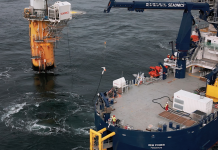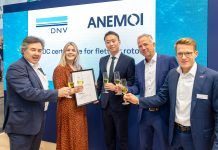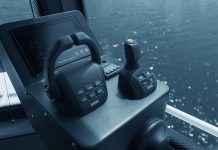The DNV GL-led wind-powered water injection (Win Win) joint industry project (JIP) shows that, for suitable fields, wind-powered water injection is technically feasible, capable of meeting performance targets, and offers a cost-competitive alternative to conventional water injection solutions.
For the past year, participants from both the renewable and oil and gas industries have worked together in the DNV GL-led Win Win JIP to develop the concept of using floating wind turbines to power a water injection system in detail and assess its technical and commercial feasibility. Technical and operational aspects as well as costs have been assessed. The JIP partners include ExxonMobil, ENI Norge, Nexen Petroleum UK Ltd., Statoil, VNG Norge, PG Flow Solutions, and ORE Catapult.
 According to DNV GL, no major challenges have been identified through the JIP’s study. Analyses of system performance examining site-specific cases from JIP partners have shown that Win Win is able to meet the operator’s key performance requirements that include injection volume targets as well as reliability and minimized downtime.
According to DNV GL, no major challenges have been identified through the JIP’s study. Analyses of system performance examining site-specific cases from JIP partners have shown that Win Win is able to meet the operator’s key performance requirements that include injection volume targets as well as reliability and minimized downtime.
“For the first time, we can now see renewable energy as a large scale source of power to offshore oil and gas operations,” said Remi Eriksen, group president and CEO of DNV GL. “By utilizing the recent developments of floating offshore wind turbines, this concept can offer a clean, reliable, and cost-effective alternative for powering water injection in offshore locations. The Win Win project showcases that the oil and gas industry can become a creative force in solving the world’s energy trilemma by driving the development of reliable, clean, and affordable technologies. This is a win for both the oil and gas and for the wind power industries.”
According to Sara Ortwein, president of the ExxonMobil Upstream Research Company, such technological advances improve the economic feasibility for wind to contribute to the overall energy supply mix.
“We are encouraged by recent advances in wind technology, particularly for niche applications such as offshore oil and gas operations,” Ortwein said.
The costs for wind-powered water injection have been compared with a conventional alternative where water is injected through a flow line from the host platform. While the Win Win technology has higher operational expenditures (OPEX) compared to a conventional alternative, the significantly lower capital expenditure (CAPEX) means that it compares favorably over the long term. Therefore, Win Win is a commercially competitive alternative in a range of cases, particularly when host platform capacity is limited or injection wells are located far away.
“For the specific example assessed in the report, we are looking at a potential cost saving of approximately 20 percent compared to a conventional solution, and this will of course vary greatly between cases,” said Johan Sandberg, project sponsor and segment leader of floating wind turbines at DNV GL. “To develop the concept further, a next step would be to test critical subsystems in a small-scale physical setup. The key objective would be to gain assurance that the components integrated in this configuration will offer satisfactory performance over time with a variable power input. A potential phase two of the JIP is being explored with some of the current JIP partners.”
Source: DNV GL
For more information, go to www.dnvgl.com.



























